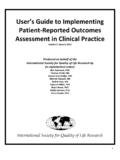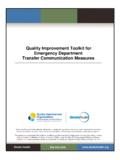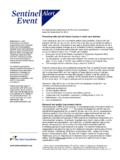Transcription of Management of the Patient With Congestive Heart Failure ...
1 Management of the Patient With CongestiveHeart Failure Using Outpatient, Home, andPalliative CareSusan E. Quaglietti, J. Edwin Atwood, Laurie Ackerman, and Victor FroelicherCongestive Heart Failure is a chronic, debilitatingillness, with increasing prevalence in the elderly. Itis one of the most common causes for hospitaladmission, and associated treatment costs are es-timated at $ billion. Despite improved survivalwith medical therapy, beneficial effects on qualityof life have not been consistently reported . In ad-dition, optimum medical therapy, as recommendedby evidence-based guidelines, are not always im-plemented. Counseling and education involving di-etary modifications,activity recommendations,medication Management , self-monitoring, progno-sis, coping skills, social support, caregiver stress,and spiritual needs are critical components in themanagement of Heart Failure through initial diagno-sis to end of life.
2 Within the last decade, closefollow-up for Congestive Heart Failure has been as-sociated with decreased hospitalizations, reducedhospital length of stay, improved functional status,better compliance, lower costs, and improved sur-vival. Research trials have mainly been observa-tional and small, and they have used different in-terventions. Little has been written regarding out- Patient Management of the Patient with advancedcongestive Heart Failure , and none of the currentpublished guidelines addresses recommendationsfor the New York Heart Association class IV (otherthan for transplant candidacy). New models ofclose follow-up for chronic and advanced conges-tive Heart Failure should be investigated. Thesemodels could be implemented in urban and ruralsettings and be supported by private insurance D 2000 by Saunders Companycongesttve Heart Failure (CHF) is a majorchrome tllness m the United States, wtth anenormous impact on health care costs.
3 It is esti-mated that more than 4 million persons m theUnited States have CHF, and it is present m ahnost10% of persons older than 70 years. It is the onlycardiovascular disease that is increasmg in inct-dence and ,L Heart Failure is the mostcommon diagnosis in hospitalized patients olderthan 65 years. One third of the patients hospital-ized for CHF are readmitted within 90 days ofdischarge. Prognosis with CHF is poor, with 1 in5 patients dying within 1 year of diagnosis andhalf within 5 Survival estimates are worsefor men than women; fewer than 20% of patients ,regardless of age or gender, survive longer than 10years, and CHF prognosis is worse m elderly sub-jects of both Annual direct health careexpendttures for CHF in the United States havebeen estimated at $20 to $40 bilhon, with $8 to$15 billion spent on hospitalization disorders of the pericardium, myocar-dium, and endocardium can lead to Heart Failure ,but 80% of CHF is due to left ventricular systolicdysfunction.
4 Coronary artery disease (CAD) is theleading cause of Heart Failure , occurring in ap-proximately two thuds of patients with CHF can be caused by hypertension(HTN), alcohol abuse, thyrotd disease, myocardi- tis, and idiopathic reasons (idiopathic-dilated car-diomyopathy). Treatment options include non-pharmacologic measures, medication therapy,and assessment for surgtcal ~8 Useof angiotension-convertmg enzyme (ACE) inhib-From the Departments of Cardiology and Home-BasedPrtmary Care, Palo Alto Veterans Affairs, Palo Alto, reprint requests to Susan Quaglietti, RN, MSN,ANP, Cardiology Dwision (lllc), VA Palo Alto HealthCare System, 3801 Miranda Ave, Palo Alto, CA o 2000 by Saunders Company0033-0620/00/4303-0005$1 in Cardiovascular Diseases, Vol 43, No 3 (November/December), 2000, pp 259-274259260 QUAGLIE77 l ET ALity by pedometer score were a srronger predictorofdeath (P < ,001) than laboratory-based exercisetests.
5 The Study to understand Prognoses andPreferences for Outcomes and Risks of Treat-ments (SUPPORT) investigators 3 found that snr-viva1 among 1,390 adult patients with CHF, withmedian age of 68 years, was only at 1 with other reported studies, a high percentageof comorbid conditions were present:-4556 withmyocardial infarction, 33% with diabetes, and20% with COPD. At 6 months, 40 6 of patientswere dependent in 1 or more activity of daily liv-ing (ADL), even though 59% of patients reportedQOL between good and rates for CHF doubled between1973 and 1986, + with the steepest increaseamong those older than 74 years. Croft et alI5reviewed Medicare hospital claims of 631,306 pa-tients from 1986 and 803,506 patients from 1993who had initial hospitalizations for CHF.
6 Age-standardized hospitalization rares for any diagno-sis of CHF was higher during 1993, discharge tohome health services doubled (6% to 12%), andmore than 25% of all admissions, regardless ofrace or sex, were in patients 85 years or older. Asexpected, the most frequently reported secondmydiagnoses were ischemic Heart disease, COPD,HTN, and diabetes. Hospitalization rates mayeven be higher, depending on which reportingmeasures are used. Goff et all6 reported that reli-ance on International Classification of Disease(ninth revision) codes during hospitalization re-sulted in missing one third of the patients withclinical evidence of acute rates 6 months postdischarge forCHF are as high as 4496, with exacerbation ofCHF accounting for 18%. There are multiple pre-cipitating factors that contribute to this exacerba-tion.
7 More than 65% of patients admitted for heartfailure exacerbation were due to lack of compli-ance with either drugs. dietary indiscretions, Other factors contributing to readmissionof older Heart Failure patients include age, gender,premature discharge, failing or nonexistent sup-port system, and polypharmacy. In addition to progressive, poor functional sta-tns and increasing hospitalization trends, outpa-tient medical Management of the Patient withCHF does nor consistently follow practice guide-lines. To improve survival. maintain and improveclinicalstatus, and prevent readmission ofpatientsitors has improved survival and is now standardtherapy unless contraindicated. Diuretics providesymptom relief by controlling fluid retention andsynergistically improve the response to otherdrugs such as ACE inhibitors and addition of beta-blocker therapy has been fa-vorable concerning symptom Management andlong-term effects.
8 Beta-blocker use also appearsbeneficial for survival. Use of spironolactone, inaddition to standard therapy, can reduce the riskof morbidity and death among patients with se-vere con-cerning dietary modifications, with sodium andfluid intake, and activity recommendations arecritical components in the Management of heartfailure that can improve quality of life (QOL). OOver the last 2 decades, new therapeutic op-tions have improved the mortality associated withleft ventricular systolic dysfunction. Within thelast 10 years, new approaches for managing heartfailure have been reported in the literature thatattempt to reduce hospitalizations from CHF andimplement guideline recommendations. Modelsaimed at care for the advanced Heart Failure pa-tient are slowly emerging.
9 This report reviews theclinical and research issues associated with inte-grated care for the Patient with CHF in the clinicand home and when palliation is the major With CHFD espite the research that has led to improved sur-viva1 with medical therapy, CHF is still a debilitat-ing. progressive disease. Burns et al describedthe impact of CHF on patients after hospitaliza-tion. Of the 519 patients with CHF reviewed, 3S%were short of breath walking less than 1 block,62% had fair or poor perceived health, 32% re-ceived some formal care, and 46% were rehospi-talized within 1 year of discharge. Many patientshad multiple medical problems: 67% with a his-tory of CHF, 4Y / with history of CAD, 14 / withhistory of chronic obstructive pulmonary disease(COPD), 37% with history of HTN and 25% withhistory of diabetes.
10 The relation of daily activitylevels in patients with CHF and long-term prog-nosis was analyzed in 84 patients with class 11 toIII Heart Failure . all with ejection fraction (ET;) lessthan 35%. patients were followed up for morethan 1 year and received various hemodynamicand exercise evaluations. Measures of daily activ-OUTPATIENT CHF MANAGEMEN with CHF, evidence-based guidelines should befollowed. Edep et al reported that there are sub-stantial differences between internists, gen-eral/family practitioners. and cardiologists for im-plementing the Agency for Health Care Policy andResearch guidelines for CHF. Only 60% to 70% ofnoncardiologists used ACE inhibitor therapy. Inaddition to underuse of medications, possibly dueto unfamiliarity with doses and side effects, over-burdened primary care providers also feel timeconstraints during clinic visits, which limit theirability to provide education on diet, exercise, prevent readmission, early discharge plan-ning that incorporates social support systems, pa-tient education concerning diet, medication, andexercise, and close medical follow-up are impor-tant components.





